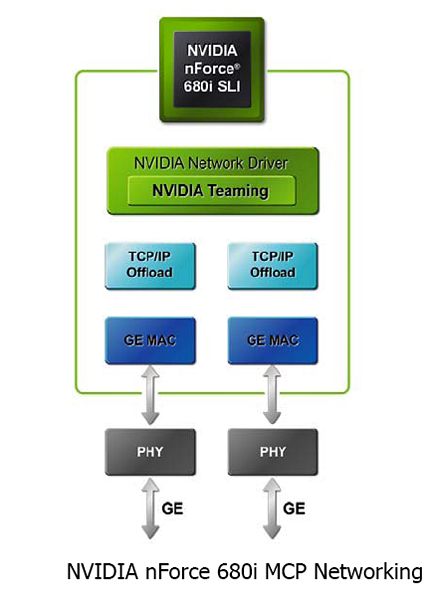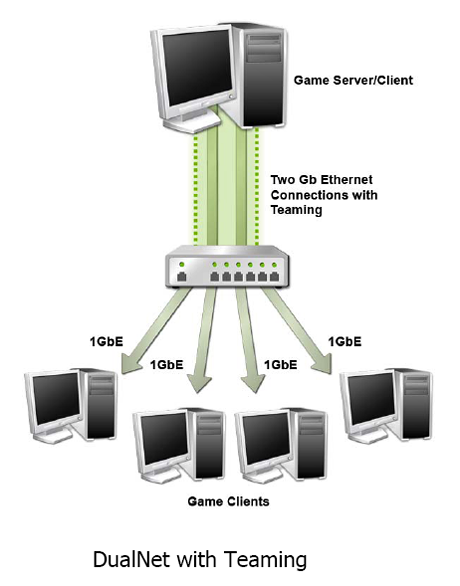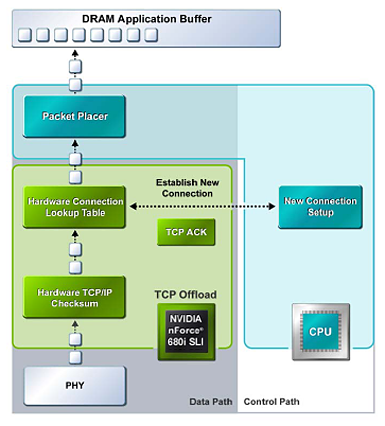NVIDIA 680i: The Best Core 2 Chipset?
by Gary Key & Wesley Fink on November 8, 2006 4:45 AM EST- Posted in
- CPUs
DualNet
DualNet's suite of options actually brings a few enterprise type network technologies to the general desktop such as teaming, load balancing, and fail-over along with hardware based TCP/IP acceleration. Teaming will double the network link by combining the two integrated Gigabit Ethernet ports into a single 2-Gigabit Ethernet connection. This brings the user improved link speeds while providing fail-over redundancy. TCP/IP acceleration reduces CPU utilization rates by offloading CPU-intensive packet processing tasks to hardware using a dedicated processor for accelerating traffic processing combined with optimized driver support.
While all of this sounds impressive, the actual impact for the general computer user is minimal. On the other hand, a user setting up a game server/client for a LAN party or implementing a home gateway machine will find these options very valuable. Overall, features like DualNet are better suited for the server and workstation market. We believe these options are being provided (we are not complaining) since the NVIDIA professional workstation/server chipsets are based upon the same core logic.

NVIDIA now integrates dual Gigabit Ethernet MACs using the same physical chip. This allows the two Gigabit Ethernet ports to be used individually or combined depending on the needs of the user. The previous NF4 boards offered the single Gigabit Ethernet MAC interface with motherboard suppliers having the option to add an additional Gigabit port via an external controller chip. This too often resulted in two different driver sets, with various controller chips residing on either the PCI Express or PCI bus and typically worse performance than a well-implemented dual-PCIe Gigabit Ethernet solution. .
Teaming

Teaming allows both of the Gigabit Ethernet ports in NVIDIA DualNet configurations to be used in parallel to set up a 2-Gigabit Ethernet backbone. Multiple computers can to be connected simultaneously at full gigabit speeds while load balancing the resulting traffic. When Teaming is enabled, the gigabit links within the team maintain their own dedicated MAC address while the combined team shares a single IP address.
Transmit load balancing uses the destination (client) IP address to assign outbound traffic to a particular gigabit connection within a team. When data transmission is required, the network driver uses this assignment to determine which gigabit connection will act as the transmission medium. This ensures that all connections are balanced across all the gigabit links in the team. If at any point one of the links is not being utilized, the algorithm dynamically adjusts the connection to ensure an optimal connection. Receive load balancing uses a connection steering method to distribute inbound traffic between the two gigabit links in the team. When the gigabit ports are connected to different servers, the inbound traffic is distributed between the links in the team.

The integrated fail-over technology ensures that if one link goes down, traffic is instantly and automatically redirected to the remaining link. If a file is being downloaded as an example, the download will continue without loss of packet or corruption of data. Once the lost link has been restored, the grouping is re-established and traffic begins to transmit on the restored link.
NVIDIA quotes on average a 40% performance improvement in throughput can be realized when using teaming although this number can go higher. In their multi-client demonstration, NVIDIA was able to achieve a 70% improvement in throughput utilizing six client machines. In our own internal test we realized about a 36% improvement in throughput utilizing our video streaming benchmark while playing Serious Sam II across three client machines. For those without a Gigabit network, DualNet has the capability to team two 10/100 Fast Ethernet connections. Once again, this is a feature set that few desktop users will truly be able to exploit at the current time. However, we commend NVIDIA for forward thinking in this area as we see this type of technology being useful in the near future.
TCP/IP Acceleration
NVIDIA TCP/IP Acceleration is a networking solution that includes both a dedicated processor for accelerating networking traffic processing and optimized drivers. The current nForce 590SLI and nForce 680i SLI MCP chipsets have TCP/IP acceleration and hardware offload capability built in to both native Gigabit Ethernet Controllers. This capability will typically lower the CPU utilization rate when processing network data at gigabit speeds.

In software solutions, the CPU is responsible for processing all aspects of the TCP protocol: Checksumming, ACK processing, and connection lookup. Depending upon network traffic and the types of data packets being transmitted this can place a significant load upon the CPU. In the above example all packet data is processed and then checksummed inside the MCP instead of being moved to the CPU for software-based processing that improves overall throughout and CPU utilization.
NVIDIA dropped the ActiveArmor slogan for the nForce 500 release and it is no different for the nForce 600i series. Thankfully the ActiveArmor firewall application was jettisoned to deep space as NVIDIA pointed out that the basic features provided by ActiveArmor will be a part of Microsoft Vista. We also feel NVIDIA was influenced to drop ActiveArmor due to the reported data corruption issues with the nForce4 caused in part by overly aggressive CPU utilization settings, customer support headaches, issues with Microsoft, and quite possibly hardware "flaws" in the original nForce MCP design.
We have found a higher degree of stability with the new TCP/IP acceleration design but this stability comes at a price. If TCP/IP acceleration is enabled via the control panel, then certain network traffic will bypass third party firewall applications. We noticed CPU utilization rates near 14% with the TCP/IP offload engine enabled and rates near 26% without it.
DualNet's suite of options actually brings a few enterprise type network technologies to the general desktop such as teaming, load balancing, and fail-over along with hardware based TCP/IP acceleration. Teaming will double the network link by combining the two integrated Gigabit Ethernet ports into a single 2-Gigabit Ethernet connection. This brings the user improved link speeds while providing fail-over redundancy. TCP/IP acceleration reduces CPU utilization rates by offloading CPU-intensive packet processing tasks to hardware using a dedicated processor for accelerating traffic processing combined with optimized driver support.
While all of this sounds impressive, the actual impact for the general computer user is minimal. On the other hand, a user setting up a game server/client for a LAN party or implementing a home gateway machine will find these options very valuable. Overall, features like DualNet are better suited for the server and workstation market. We believe these options are being provided (we are not complaining) since the NVIDIA professional workstation/server chipsets are based upon the same core logic.

NVIDIA now integrates dual Gigabit Ethernet MACs using the same physical chip. This allows the two Gigabit Ethernet ports to be used individually or combined depending on the needs of the user. The previous NF4 boards offered the single Gigabit Ethernet MAC interface with motherboard suppliers having the option to add an additional Gigabit port via an external controller chip. This too often resulted in two different driver sets, with various controller chips residing on either the PCI Express or PCI bus and typically worse performance than a well-implemented dual-PCIe Gigabit Ethernet solution. .
Teaming

Teaming allows both of the Gigabit Ethernet ports in NVIDIA DualNet configurations to be used in parallel to set up a 2-Gigabit Ethernet backbone. Multiple computers can to be connected simultaneously at full gigabit speeds while load balancing the resulting traffic. When Teaming is enabled, the gigabit links within the team maintain their own dedicated MAC address while the combined team shares a single IP address.
Transmit load balancing uses the destination (client) IP address to assign outbound traffic to a particular gigabit connection within a team. When data transmission is required, the network driver uses this assignment to determine which gigabit connection will act as the transmission medium. This ensures that all connections are balanced across all the gigabit links in the team. If at any point one of the links is not being utilized, the algorithm dynamically adjusts the connection to ensure an optimal connection. Receive load balancing uses a connection steering method to distribute inbound traffic between the two gigabit links in the team. When the gigabit ports are connected to different servers, the inbound traffic is distributed between the links in the team.

The integrated fail-over technology ensures that if one link goes down, traffic is instantly and automatically redirected to the remaining link. If a file is being downloaded as an example, the download will continue without loss of packet or corruption of data. Once the lost link has been restored, the grouping is re-established and traffic begins to transmit on the restored link.
NVIDIA quotes on average a 40% performance improvement in throughput can be realized when using teaming although this number can go higher. In their multi-client demonstration, NVIDIA was able to achieve a 70% improvement in throughput utilizing six client machines. In our own internal test we realized about a 36% improvement in throughput utilizing our video streaming benchmark while playing Serious Sam II across three client machines. For those without a Gigabit network, DualNet has the capability to team two 10/100 Fast Ethernet connections. Once again, this is a feature set that few desktop users will truly be able to exploit at the current time. However, we commend NVIDIA for forward thinking in this area as we see this type of technology being useful in the near future.
TCP/IP Acceleration
NVIDIA TCP/IP Acceleration is a networking solution that includes both a dedicated processor for accelerating networking traffic processing and optimized drivers. The current nForce 590SLI and nForce 680i SLI MCP chipsets have TCP/IP acceleration and hardware offload capability built in to both native Gigabit Ethernet Controllers. This capability will typically lower the CPU utilization rate when processing network data at gigabit speeds.

In software solutions, the CPU is responsible for processing all aspects of the TCP protocol: Checksumming, ACK processing, and connection lookup. Depending upon network traffic and the types of data packets being transmitted this can place a significant load upon the CPU. In the above example all packet data is processed and then checksummed inside the MCP instead of being moved to the CPU for software-based processing that improves overall throughout and CPU utilization.
NVIDIA dropped the ActiveArmor slogan for the nForce 500 release and it is no different for the nForce 600i series. Thankfully the ActiveArmor firewall application was jettisoned to deep space as NVIDIA pointed out that the basic features provided by ActiveArmor will be a part of Microsoft Vista. We also feel NVIDIA was influenced to drop ActiveArmor due to the reported data corruption issues with the nForce4 caused in part by overly aggressive CPU utilization settings, customer support headaches, issues with Microsoft, and quite possibly hardware "flaws" in the original nForce MCP design.
We have found a higher degree of stability with the new TCP/IP acceleration design but this stability comes at a price. If TCP/IP acceleration is enabled via the control panel, then certain network traffic will bypass third party firewall applications. We noticed CPU utilization rates near 14% with the TCP/IP offload engine enabled and rates near 26% without it.










60 Comments
View All Comments
MikeyC - Friday, November 10, 2006 - link
I'm looking forward to this. Any idea on when you guys will have the bin numbers for the different rates of OC-ability? I'm planning on OCing my e6600 on this board this weekend; I'll post up my numbers if that'll help.Gary Key - Sunday, November 12, 2006 - link
We have not figured it out yet. Two CPUs from the same week and they both act differently during overclocking. We are still working with NVIDIA on this matter.Joepublic2 - Friday, November 10, 2006 - link
965 and 975 boards to my knowledge don't support a FSB/mem ratio smaller than 1:1. Does this chipset have the right multiplier to use DDR2-400 while retaining a 1066Mhz FSB?Gary Key - Friday, November 10, 2006 - link
The memory settings are sync or async capable on this chipset if you unlink the FSB and Memory in the BIOS. So the answer is yes to your question but believe me this chipset needs good DDR2-800 to get the most out of it. A 1T command rate can make a significant difference in several applications and games. We already found a 4FPS difference in Q4 at 1280x1024 with DDR2-800 at 1T instead of 2T as an example. We will have more on this in our actual board review.Joepublic2 - Monday, November 13, 2006 - link
I was asking mainly because a conroe board that could run a 4:3 FSB/mem multiplier could be an even better overclocker than the 965. One would only need RAM that could hit DDR 752 for a 500Mhz FSB for example.A great review as always!
VooDooAddict - Friday, November 10, 2006 - link
Any idea if there are mATX boards using any of thse new chipsets on the way?Gary Key - Friday, November 10, 2006 - link
There is the possibility of the 650i Ultra being on a mATX board in late January. However, the suppliers might wait for the new NV Intel IGP chipset coming in Q1. We should have more information in December.
BadThad - Thursday, November 9, 2006 - link
Should be CPU, the X6800 is not a GPU, lol.
Wesley Fink - Friday, November 10, 2006 - link
Correctedyacoub - Thursday, November 9, 2006 - link
Do all of the 680i SLi boards require active cooling on the northbridge? That's actually a deal-killer for me, as motherboard fans are about the worst ones out there anymore since they're small, fast-spinning (and due to those two characteristics they are noisy), usually short-lived, and I've yet to see one that is dynamically controlled by the temp of the northbridge.I'm guessng 650i boards don't require active cooling, but are any of the 680i boards using a non-reference design sporting completely silent cooling?